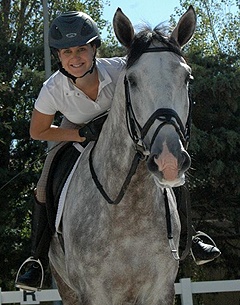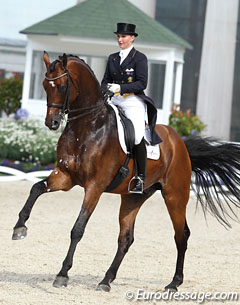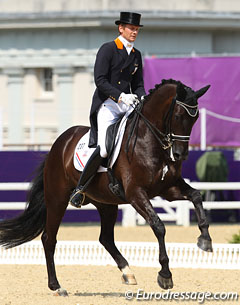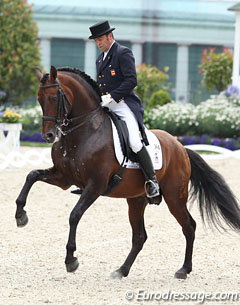
When I first began the flying changes with my 6-year old I was so scared I would stuff them up. My talented rider/trainer Joao Moreira had been helping me a lot with the work and I thought it would be a great idea for him to just hop on and teach my horse the changes.
However my wise mum said that changes are a deeply personal aspect of training and there is a reason why many top professionals refuse to attempt changes in master classes.
What the aid is may be told to you, but every rider will practice this aid with a unique variation and a horse must learn to respond to their rider's command. Having more than one rider teach the changes will merely confuse the horse and even if you think the aid is the same, the strength, efficiency, and overall posture of the rider will always be different!
So I had to do it myself, with Joao's help of course.
The most important thing in preparing for the changes is getting the canter/walk walk/canter transitions perfect!
"When the horse executes the transitions from canter to walk calmly and strikes off equally well anywhere in the arena, he is ready for the flying changes" N.Oliveira (1998, 87).
Given that my horse's canter work had now become well balanced and with good impulsion, I began to work more on the transitions, making sure he was not only straight and through, but also responded to a light aid in the canter strike off. However, even if your horse has a super canter and you think it will be easy for him to learn the changes, pick your days.
"To get a good flying change, one has to perfect the original canter above all" N.Oliveira (1998, 87).
The original canter, even if it is perfect, may not be the canter for the flying changes, which is again a very personal thing and you need to feel when to ask and when to spend the day just doing the preparation. The "changes canter" is not always your horse's best canter, nor is it his worst; it is a canter that has bounce and you cannot be told which canter is right, as you must feel it as the rider!
"In order for the flying changes to be good, one needs a springy canter. One has to feel that the horse has bascule" N.Oliveira (1998, 87).
So, when you feel the horse is on a "changes canter" day, you have energy and sensitivity and bounce....On the long side of the arena I began to work the canter, sitting the horse back and then allowing with my reins to make sure he was maintaining his own self-carriage. Then I would begin canter/walk, five good steps of walk, into counter canter. Then Walk again, five steps good walk, back into canter.
When I had this working well, with five even balanced and relaxed walk steps, I began to reduce the amount of walk steps allowed: Four, then three, then two, ensuring all the time that I used light aids into the canter and that the downward transition was smooth and coming from behind. This is a great exercise to get the horse sensitive and aware of the aid for the canter strike off. Be sure during the canter to always keep the outside leg back and touching, to remind the horse which leg you want in the lead.
 On a light horse, whose rider has both strength and technique, you may then be able to take the long side and do the transition with no walk steps, i.e. make the change. However, I am small and my horse has a lot of power, so I needed an exercise to ensure his weight was in the right position and he had enough impulsion to make the change.
On a light horse, whose rider has both strength and technique, you may then be able to take the long side and do the transition with no walk steps, i.e. make the change. However, I am small and my horse has a lot of power, so I needed an exercise to ensure his weight was in the right position and he had enough impulsion to make the change.
Joao Moreira instructed me to carry out an exercise using leg yield to push the horse's weight across, all the while increasing his activity and his attention to me. Taking the centreline in right canter with my outside (left) leg back, I put the horse into leg yield to the right in canter and moved him steeply back towards the wall, keeping the bend slightly to the left. When I reached the wall, I would straighten him, move forward with two good counter canter strides, then simultaneously take my left leg off and move my right leg back and on, to ask the change. This worked really well and it helped my horse with activity, sensitivity and straightness all in one exercise.
On that first day I got four really top changes, mixed with a couple that were hit and miss. The next day, when I began the lesson, Batialo was working really well, producing his best in the trot, canter and the walk. I should have just left it. Stupidly I decided to repeat the exercise from the day before, and of course, he was still tired and was not with the "changes canter", and so it was not so great. This day I should have just done the exercise, but not asked the change, and aim to keep a well balanced, active counter canter around the short side and across the diagonal into a working canter.
After the change, don’t act like it’s all over. The canter after the change is equally as important as the change itself and to later teach the tempi changes you must ensure the horse stays straight and maintains the rhythm after the change!
"Don't allow the horse to run away after the flying change" N.Oliveira (1998, 89).
Judge Angelika Frömming Weighs In on the Flying Change
 Former international 4-star judge Angelika Froemming gave me some insight into what a judge is looking for in order to award the top marks for the flying change. First, Angelika points out the most common mistakes that riders make when preparing for the change.
Former international 4-star judge Angelika Froemming gave me some insight into what a judge is looking for in order to award the top marks for the flying change. First, Angelika points out the most common mistakes that riders make when preparing for the change.
"The mistakes that we see depend very much on the stage of training of horse and rider," said Angelika. "In the lower classes it is often a lack of experience of the horse and/or of the rider. Quite often, within the test, the horses are not well prepared for the flying change. For example the quality of the canter is not good enough, the horse is tense in the back or in the poll. Alternatively the rider can give the aid in an incorrect manner, either not at the correct moment, with not enough precision, or too highly exaggerated!"
According to Angelika these errors usualy occur due to a lack of experience, lack of training of rider and horse, or a lack of feeling. "The lowest mark I will ever award for a change, however, is if the change of leg is done by trotting or even by one walk step."
The height of this low mark will depend on what is asked for on the test sheet and what criteria the horse and rider were meant to fulfill. "If the judges have to give a mark only for the flying change it will be a 0 because there was no flying change at all, the change was just done by trotting or walking," she said. "But if beside the flying change the quality of the canter before or after the flying change has to be judged, you might give a 1 or a 2, even if the change was done by brake into trot or walk. Then the quality of the canter is part of the value of the whole exercise, very often on the short side of the arena. I give a 0 if it is just the flying change on the test sheet and if there is nothing to judge regarding the quality of the canter before or after the flying change."
Angelika pointed out that there are quite often discussions about giving a 0 in such a situation, but really, what can you award in this case?
"If an exercise is not shown at all, it is not shown," she stated firmly.
Agreeing that the quality of the canter is the most important thing in getting a great flying change, there is not one thing in particular that Angelika looks for and she knows that for the top marks it just has to have everything. "Judges look at the total: jumping through in a real springy, not flat stride, freedom out of the shoulder, poll highest point with the nose line slightly ahead of the vertical, no contracted neck, swinging, not getting wide behind, nearly invisible aid."
 In dressage horse tests for 6-year old horses, the judges are more lenient for the formal correctness at the required marker, but in those tests there are no scores for the flying changes. Flying changes are valued under submission including the lateral movements. The judges want to see whether the horses are on the right way of training, also on the right way of training the flying changes. In a dressage test – for a high score the flying change has to be correct.
In dressage horse tests for 6-year old horses, the judges are more lenient for the formal correctness at the required marker, but in those tests there are no scores for the flying changes. Flying changes are valued under submission including the lateral movements. The judges want to see whether the horses are on the right way of training, also on the right way of training the flying changes. In a dressage test – for a high score the flying change has to be correct.
While there are many criteria involved in a great flying change, Angelika stressed that really, concerning the quality of the change, more or less nothing can be overlooked. "Everyone wants to have an 8 or a higher score, but that means that everything must be good," she re-affirmed.
To get 8's or higher, you must first put the change in the horse's head and the truth is there is no one way to teach a horse changes. Every horse is different, and you need to find the right exercise for you and your horse. The most important aspect is establishing the canter to walk transitions, knowing how to pick the "changes canter," and then finding an exercise that puts the horse's weight in the right place, so that it doesn't make you tangle yourself up, or throw yourself all about the place. If you try to confuse yourself about putting the horse's shoulders here, or haunches in, don't! Straightness is the most effective way to keep the balance in the change!
“One of the secrets of the flying changes is to have the horse's shoulders on the same line as the haunches. Many riders start it with the haunches coming in" N.Oliveira (1998, 87).
If you are trying an exercise and you can feel that the horse is not straight and that you will not get the change, don't ask. Think about why you don't feel ready, where is the horse's weight? Is he falling out through the shoulder? Or is he ready to fly off to the other side and fall onto your inside leg as you change? If yes, find the exercise that can limit this, i.e.. If your horse is falling to the new side as he changes and losing balance, do the change into counter canter against the wall.
Then when you find an exercise that works, use it until he gets the idea, then gradually introduce the changes in different spots.
Hopefully, one day, you will be skipping along with ease!
By Sarah Warne for Eurodressage
Related Link
Sarah Warne's Classical Training Articles